Off-road Vehicles & Snowmobiles
This handbook is only a guide. For official purposes, please refer to the Highway Traffic Act, the Motorized Snow Vehicles Act and the Off-road Vehicles Act of Ontario.
If you're taking beginner driver education, make sure it’s from a ministry-approved school.
For more information about driver licensing, visit the website.
To request a copy of this book in an alternate format, contact Publications Ontario at 1-800-668-9938 or (416) 326-5300 or visit ServiceOntario Publications.
Disponible en français. Demandez le « Guide officiel de l'automobiliste de publié par le MTO »
Driving is a privilege - not a right
Introduction
Off-road vehicles and snowmobiles are popular forms of recreation for many people in Ontario. They are also necessary for transportation in remote areas and in emergencies. But these vehicles are not toys. If you intend to use them, you must know how they work, how to drive them safely in different situations and how Ontario laws apply to them.
It is important to remember that off-road vehicles are intended for off-road use. Dirt bikes cannot be driven on public roads, although snowmobiles can be in some areas. Off-road vehicles are allowed to travel directly across some highways. However only single-rider, all-terrain vehicles can be driven on the shoulder of some provincial highways and municipal roads where bylaws permit.
This section of the handbook contains information about Ontario’s laws and safe driving tips for snowmobiles and off-road vehicles. As you read, remember it is a guide only. For official purposes, please refer to the Highway Traffic Act, the Motorized Snow Vehicles Act, the Off-road Vehicles Act, the Trespass to Property Act and the Occupiers' Liability Act of Ontario. The applicable legislation can be accessed online through Ontario’s e-Laws website.
Note: Alcohol presents a major risk to your safety and the safety of others whether you are driving a car, motorcycle, snowmobile or off-road vehicle. Drinking affects your ability to operate your vehicle and increases your chances of having a collision.
Driving a snowmobile
This chapter tells you what you need to know to drive a motorized snow vehicle in Ontario. This includes age requirements, registration, where you can and cannot drive, safety tips, traffic signs and signals and the Snowmobiler’s Code of Ethics.
I. Getting ready to drive a snowmobile
What you need to drive a snowmobile in Ontario
You can drive a snowmobile if you have a valid Ontario driver’s licence (any class). If you do not have a driver’s licence and you are 12 years of age or older, a valid motorized snow-vehicle operator’s licence (MSVOL) will allow you to drive on trails established and maintained by a recreational organization for the use of snowmobiles. However, you must be 16 years of age or older and have a driver’s licence or a motorized snow-vehicle operator’s licence (not both) to drive a snowmobile along or across a public road where snowmobiles are allowed.
An MSVOL is issued by the Ontario Federation of Snowmobile Clubs in co-operation with the Ministry of Transportation. You must successfully pass a snowmobile driver-training course to get a licence. (For more information on how to get a motorized snow-vehicle operator’s licence.
If you are a visitor to Ontario and wish to drive a snowmobile while you are here, you must have a valid licence that allows you to drive a snowmobile in your home province, state or country.
You must carry your driver’s licence or snow-vehicle operator’s licence when you are driving your snowmobile anywhere other than on your own property. You must show it when asked by a police or conservation officer.
If your driver’s licence or snow-vehicle operator’s licence has been suspended, you may not drive any type of vehicle on or off any roads or in any public place.
Registering and insuring your snowmobile
Before driving a snowmobile, it must be registered with the Ministry of Transportation through a ServiceOntario centre. This applies to new or used snowmobiles that have never been registered, and snowmobiles previously registered in another jurisdiction. If you buy a new snowmobile, it must be registered within six days of sale. You can download and complete a registration form before visiting a ServiceOntario centre.
If you buy a new snowmobile, your dealer will register it with the Ministry of Transportation within six days of the sale. If you buy a used snowmobile that has been previously registered, you will simply need the signed snow-vehicle permit and the bill of sale to transfer the registration into your name.
You must pay a fee to register your snowmobile. This is a one-time fee to be paid by the owner of the snowmobile. After registering, you will be given a permit and a registration number decal to display on your snowmobile.
Attach the decal to each side of your snowmobile’s cowling or engine cover. It should be placed so that the start of the registration number is between 10 and 15 centimetres from the rear of the cowling. If the decal cannot be placed on the cowling because of the design of the vehicle, place the decal on each side of the tunnel, near the light reflector.
Unless you are driving your registered snowmobile on your own property or you are a resident of northern Ontario that is exempt, you must have a validation sticker on your registration decal. You must carry your driver’s licence or MSVOL and evidence of your vehicle’s registration at all times and show it to a police or conservation officer when asked.
Snowmobiles are only permitted on public highways when directly crossing. In specific circumstances, snowmobiles can operate on the non-serviced portion of some highways. Local municipalities also have authority to pass bylaws governing the use of snowmobiles on highways under their jurisdiction.
There is an annual renewal fee for the sticker. Place the sticker in the upper right corner of the decal.
You must also have liability insurance to drive your snowmobile off your own property. Carry the insurance card given to you by the insurance company for the snowmobile, and show it when a police or conservation officer asks for it. If someone else uses your snowmobile with your consent, you are both responsible for any penalties, damages or injuries that may occur.
There are separate requirements and rules regarding the operation of trail grooming equipment. Make sure you know what is required before operating grooming equipment.
Wear a helmet
You must wear a helmet whenever you drive or ride on a snowmobile or any kind of toboggan or sled towed by a snowmobile. Although you do not require a helmet when you operate a snowmobile on your own land, it is recommended that you wear one for safety reasons. The helmet must meet the standards approved for motorcycle helmets, or motor-assisted bicycle helmets, and must be fastened properly under the chin.
Protect your eyes and face
Always wear a face shield or goggles. A face shield can help prevent windburn, frostbite, sunblindness and watering eyes from the wind. A face shield can also protect your eyes from branches and twigs when driving through wooded areas. Select lightly tinted and shatterproof shields or goggles to match conditions. For example, choose clear plastic for dull, cloudy days and deep yellow for late afternoon when flat light can hide depressions in the snow. Avoid dark-tinted shields or goggles, which can restrict your vision.
Make sure your snowmobile is in good condition
Before every trip, check your snowmobile to make sure it is in good working order. Your life may depend upon it. Do the following:
- Check the steering mechanism. Turn the handlebars back and forth to make sure the turning is smooth and unrestricted.
- Check the condition and tension of the motor drive belt. Change it if necessary or if you are in doubt about its reliability.
- Check the emergency switch, headlights and tail lights.
- Check the battery solution level.
- Check the throttle and brake levers. Make sure they move freely.
- Check the spark plugs and the tank’s fuel level. Do not use matches or a lighter when doing this, and never add fuel when the motor is running.
When towing a toboggan, sled or any other kind of vehicle behind a snowmobile, be sure to use a rigid tow bar and a safety chain. For safety, towed vehicles must have reflective material on the front sides, rear sides and rear to make them more visible. Towing is generally not allowed on public roads except to cross the road at a 90-degree angle. This does not apply to a snowmobile being used to free a stuck vehicle, for any emergency rescue or for trail maintenance.
Before you drive anywhere, read the owner’s manual carefully and keep it in your snowmobile at all times.
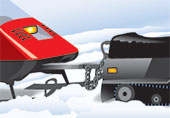
Be well prepared for every trip
Carefully preparing for every trip is an important part of safe snowmobiling. Check local weather forecasts and local ice conditions before heading out, as they can change in a matter of hours. Avoid travelling on unmarked frozen lakes and rivers. Make sure you tell someone where you will be travelling and when you expect to be back. Use the buddy system; do not drive your snowmobile alone and always ride within your abilities and according to conditions.
Take along a first-aid kit, a vehicle repair kit, an extra ignition key, a drive belt, spark plugs and a rope. On long trips, include a map and a compass (or a GPS unit and know how to use it), flashlight, hunting knife, hatchet, extra fuel, matches in a waterproof box and high-energy food such as granola bars. If you travel over frozen lakes and rivers, wear a buoyant snowmobile suit and carry ice picks to improve the chances of survival if you break through the ice.
II. Safe and responsible snowmobiling
Where you can and cannot drive
You may drive your registered snowmobile on your own property, on the private trails of organizations to which you belong, on private property when you have the owner’s permission or in permitted public parks and conservation areas.
Snowmobiles are only permitted on public highways when directly crossing. In specific circumstances, snowmobiles can operate on the non-serviced portion of some highways. Local municipalities also have the authority to pass bylaws governing the use of snowmobiles on highways under their authority.
You may not drive a snowmobile on certain high-speed roads, freeways, the Queen Elizabeth Way, the Ottawa Queensway and the Kitchener-Waterloo Expressway. This includes the area around these roads, from fence line to fence line. You may not drive on the serviced section of a road (from shoulder to shoulder) except to cross. When crossing, you must slow down, stop and then proceed at a 90-degree angle. When riding in a group, do not motion the driver behind you to cross. Let each rider assess oncoming traffic and decide for themselves when it is safe to cross. If visibility is restricted at the crossing, you may then wave to the driver behind you that the way is clear.
Except where prohibited, you may drive your snowmobile along public roads, keeping as far away from the road as possible in the section between the shoulder and the fence line. Local municipalities may pass bylaws that regulate or prohibit snowmobiles anywhere within their boundaries, on or off public roads. Make sure you are aware of the bylaws in the municipality where you intend to snowmobile.
You may not drive a snowmobile on railway tracks unless you have permission from the railway track authority.
Public trails
Ontario’s public trails are established and maintained by many snowmobile clubs. They are patrolled by Ontario Provincial Police, municipal police, conservation officers and Snowmobile Trail Officer Patrol officers. Some clubs require snowmobiles to have and display a trail permit to drive on their trails. Some other clubs allow their trails to be used without a trail permit. Trails may have signs stating that a trail permit is required. If you are unsure, check with the local snowmobile club to find out if you need a trail permit.
For trails operated by the Ontario Federation of Snowmobile Clubs, you must have and display a trail permit. This includes trails on private property, municipal property and land owned by the government. Some snowmobile-trail user groups are exempt from the permit requirement. Those who are eligible for exemption and the documents required as proof are included in the trail-permits section of the regulations of the Motorized Snow Vehicles Act. Snowmobilers who are exempt must carry the appropriate documents and show them when requested to do so.
For information about trails and trail permits, contact your local snowmobile club or the Ontario Federation of Snowmobile Clubs, 501 Welham Road, Unit 9, Barrie, ON L4N 8Z6. Phone 705-739-7669; fax 705-739-5005; or e-mail at info@ofsc.on.ca. You can visit the OFSC website.
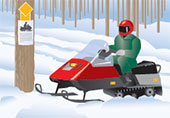
Do not trespass
You are trespassing if you drive your snowmobile on private property without permission from the owner. The owner is not required to have a “No Trespassing” sign posted. If you are driving your snowmobile on private property, you must stop and identify yourself when asked by the police, the owner of the property or a representative of the owner. If you are told to leave the property, you must do so immediately.
You may be fined if you are convicted of trespassing. In addition, you may be ordered to pay damages. Under certain circumstances, you may also be required to pay for the cost of prosecuting. Charges will be laid against the driver of the snowmobile. If the driver is not known, the owner may be charged if the snowmobile was used with the owner’s permission.
A copy of the Trespass to Property Act is available through Publications Ontario. Phone (416) 326-5300 or 1-800-668-9938. It is available over the Internet at ServiceOntario Publications and Ontario’s e-Laws website.
It is an offence under the Railway Safety Act to trespass on railway tracks.
Obey the speed limits
You must not drive a snowmobile faster than 20 km/h in any public park or exhibition ground, or on any road where the speed limit for other vehicles is 50 km/h or less. You must not drive faster than 50 km/h on snowmobile trails or on any road where the speed limit for other vehicles is more than 50 km/h. Always leave extra space between you and the snowmobile in front to give yourself more time to react to unexpected hazards and stop safely. Lower your speed at night and don't outrun your headlights. Reduced nighttime visibility makes hazards more difficult to spot and estimating distance is much harder. Always wear clothing with reflective markings to remain visible at night.
Municipalities may set other speed limits for snowmobiles on public roads, trails and parks within their boundaries. Check municipal bylaws.
Stop for police
You must come to a safe stop when requested by a police officer to do so. If you do not stop, you may have to pay a fine or go to jail, or both. If you are convicted of failing to stop for a police officer and the court believes you wilfully avoided police during pursuit - that you tried to escape the police - your licence will be suspended for a minimum of five years. Your licence can be suspended for up to 10 years if anyone is killed or injured as a result of avoiding police.
Report collisions to the police
You must report to the police immediately any collision that results in injury to any person or damage to property apparently exceeding $400.
Do not drink and drive
Alcohol is a major factor in snowmobile fatalities. Consuming any amount of alcohol before you ride affects your ability to make good decisions. Alcohol also increases fatigue, slows reaction time and increases your risk of hypothermia.
It is against the law to drive a snowmobile when you are impaired by alcohol or drugs.
Drinking and driving is a deadly combination. All drivers, especially inexperienced drivers, must be able to concentrate on driving.
Consuming any amount of alcohol before you ride affects your ability to make good decisions. Even one drink can reduce your ability to concentrate and react to things that happen suddenly when you are driving. With more alcohol in your blood, you could have trouble judging distances and your vision may become blurred. Factors like tiredness, your mood, and how long ago you ate and how much, can make a difference in how alcohol affects your driving ability.
The police can stop any driver to determine if alcohol or drug testing is required. They may also do roadside spot checks. When stopped by the police, you may be told to blow into a machine that tests your breath for alcohol, a roadside screening device, or perform physical co-ordination tests. If you fail or refuse to provide a breath sample or to perform the physical co-ordination tests, you will be charged under the Criminal Code.
If the reading on the machine shows you have been drinking, you may be taken to a police station for a breathalyzer test. The breathalyzer uses your breath to measure the amount of alcohol in your bloodstream.
If you cannot give a breath sample or it is impractical to obtain a sample of breath, the police officer can require you to provide a blood sample instead.
If the police believe that a driver is impaired because of the consumption of a drug or a combination of alcohol and a drug, they can also require a driver to submit to an evaluation and then require a driver to provide blood, oral fluid or urine samples. If you fail or refuse to comply with any of these demands, you will be charged under the Criminal Code.
Driving impaired or with more than 80 milligrams of alcohol in 100 millilitres of blood (.08) is an offence under the Criminal Code. Even if your blood-alcohol concentration is less than .08, you can still be charged with impaired driving under the Criminal Code.
You will receive an immediate 90-day administrative driver’s licence suspension if your blood-alcohol concentration (BAC) is more than .08 or if you fail or refuse to provide a breath or bodily fluid sample, perform a physical co-ordination test or submit to an evaluation.
If you register in the “warn range” of .05 to .08 on a roadside screening device, you will receive an immediate driver’s licence suspension. For a first occurrence, you will be suspended for three days. For a second occurrence in a five-year period, you will be immediately suspended for seven days and you must undergo a remedial alcohol-education program. For a third or subsequent time in a five-year period, you will be immediately suspended for 30 days, and you must undergo a remedial alcohol-treatment program and have an ignition interlock condition placed on your licence for six months. If you choose not to install an ignition interlock device, you must not drive until the condition is removed from your licence.
If you are 21 years old and under and hold a full-class driver’s licence, you must not drive if you have been drinking alcohol. Your blood-alcohol level must be zero. If you are caught driving with alcohol in your blood, you will receive an immediate driver’s licence suspension at the roadside for 24 hours and, if convicted, you will face a fine and a 30-day licence suspension.
Drivers of all ages in either Level One or Level Two of Ontario’s graduated licensing system must also have a blood-alcohol level of zero when driving. New drivers caught drinking and driving will receive an immediate driver’s licence suspension at the roadside for 24 hours and, if convicted, will face a fine and will receive a suspension period as per the Novice Driver Escalating Sanctions scheme. For the first occurrence, you will be suspended for 30 days. For the second occurrence, in a five-year period, you will be suspended for 90 days. For the third occurrence in a five-year period, the novice portion of your driver’s licence will be cancelled, and you must reapply for a G1 licence.
Novice drivers will also be charged under the Criminal Code if their BAC exceeds .08 and will be issued a warn-range suspension if they register between .05 and .08.
Drugs
Any drug that changes your mood or the way you see and feel about the world around you will affect the way you drive. Criminal Code and HTA sanctions apply to drivers impaired by alcohol or a drug.
In circumstances involving possible impairment by drugs or a combination of alcohol and a drug, police can require a driver to perform physical co-ordination tests and to submit to an evaluation, and then require a driver to provide blood, oral fluid or urine samples. If you fail or refuse to comply with any of these demands, you will be charged under the Criminal Code. You will also receive an immediate 90-day administrative driver’s licence suspension. Illegal drugs such as marijuana and cocaine are not the only problem. Some drugs that your doctor may prescribe for you and some over-the-counter drugs can also impair your driving.
Here are some points you should remember:
- If you use prescription medicines or get allergy shots, ask your doctor about side effects such as dizziness, blurred vision, nausea or drowsiness that could affect your driving.
- Read the information on the package of any over-the-counter medicine you take. Any stimulant, diet pill, tranquillizer or sedative may affect your driving. Even allergy and cold remedies may have ingredients that could affect your driving.
- Drugs and any amount of alcohol together can have dangerous effects, even several days after you have taken the drug. Do not take a chance - ask your doctor or pharmacist.
Practice safe snowmobiling
Driving a snowmobile requires the same attention and alertness that driving any other kind of vehicle does. You must have complete control of your reflexes. If you are a beginner, practise until you can handle the basic driving skills.
Learn how to control your balance on turns by using your weight to control your movements and leaning in the direction you want to turn. Position your body on the snowmobile in a way that will give you the most comfort and control for the conditions in which you are driving. On level ground, sit or kneel with both knees on the seat. On uneven or bumpy ground, stand on the running boards with your knees slightly bent.
Always take the time to plan your route before you ride and make sure others in your group know the route as well. If you must stop on the trail, always select a location where you will be visible and pull over to the right as far as possible. If you are riding in a group, you should park the snowmobiles in single file and leave the vehicles running so you are visible at night.
On hard-packed snow or ice, reduce your speed, because stops and turns are harder to make and you will require greater distance to complete them. When your snowmobile is trapped in deep snow, remember to turn off the motor before you try to get it out of the snow.
Every time you travel on ice, you are risking your safety and that of your passenger. Watch out for pressure cracks that are much more difficult to spot at night. If you are in an unfamiliar area, ask local authorities or residents about the ice conditions, inlets, outlets, springs, fast-moving current or other hazards. Listen to local radio broadcast warnings by the Ontario Provincial Police about ice conditions. If you must drive over frozen lakes or rivers, you should consider using a buoyant snowmobile suit. It might save your life.
Whenever you are driving, always watch for trails and highway, signs and obey them. Always remain on the right-hand side of the trail when riding and exercise caution on hills and curves. You should always be prepared for the unexpected. Exercise caution at road and rail crossings. Trucks and trains often kick up large clouds of snow that greatly reduce visibility. Carry a cell phone with you when riding.
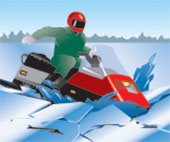
III. Snowmobile signals and signs
Hand signals
Signals tell others what you want to do, giving them a chance to slow down, stop or prepare to turn. Use hand signals to signal before stopping, slowing down suddenly or turning. Give the correct signal well before the action and make sure others can see it. These illustrations show nationally recognized hand and arm signals.
Left turn
Extend your left arm straight out and point in the direction of the turn.

Right turn
Raise your left arm to shoulder height with elbow bent.
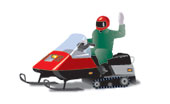
Stop
Extend your right arm straight up over your head with the palm of the hand flat.
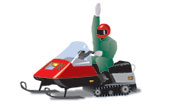
Slowing
Extend your left arm out and down the side of your body. Flap your arm up and down to signal caution.
Oncoming snowmobiles
Raise your left arm to shoulder height with your elbow bent and motion left to right over your head, pointing to the right side of the trail.
Snowmobiles following
Raise left arm to shoulder height with your elbow bent. Motion front to back over your shoulder with your thumb, like a hitchhiker.
Last snowmobile in line
With elbow bent, raise your left forearm to shoulder height and clench your fist.
Trail signs
Trail signs give you important information about what to do in certain situations. Here are some common trail signs and what they mean. Because trail signs are not official traffic signs, they may vary in shape and colour. Watch for signs such as these and obey them.
Stop
A stop sign is eight-sided and has a red background with white letters. Come to a complete stop.

Stop ahead
Be prepared to stop for a stop sign up ahead.
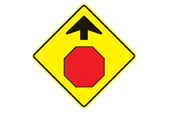
Snowmobiling permitted
A sign with a green circle means you may do the activity shown inside the ring. You may drive a snowmobile in the area where this sign is displayed.
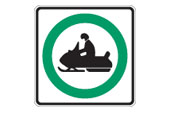
Snowmobiling restricted
A sign with a red circle with a line through it means the activity shown inside the ring is not allowed. Do not drive a snowmobile in the area where this sign is displayed.
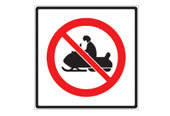
Direction signs
These signs give you information about the direction in which you should travel on the trail. Do as the sign tells you.
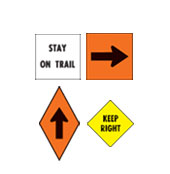
Traffic signs
If you are driving your snowmobile along or across any public roads, you need to be aware of traffic signs and what they mean. The following traffic signs relate specifically to snowmobiles.
Snowmobiles permitted
Snowmobiles are allowed on the road or highway where this sign is displayed.
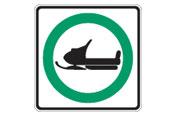
Snowmobiles restricted
Snowmobiles are not allowed on the road or highway where this sign is displayed.

Snowmobiles crossing
These signs warns drivers that snowmobiles are allowed to cross the road.
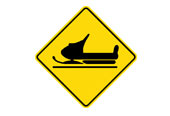
Wind-chill factor
It is important to consider the wind-chill factor when planning outdoor winter activities.
Wind-chill factor is the combined effect of wind and low temperature, which makes it feel much colder on a windy day in winter than is the actual temperature. This is caused by the faster cooling effect of the wind. For example, if the actual temperature is -10°C and the wind speed is 40 km/h, the temperature feels like -31°C.
You need to be aware of the wind-chill factor so that you can dress appropriately. Outer layers that are waterproof and multiple under-layers of clothing provide added protection, and allow you to take clothing off if temperatures increase. Also, make sure that young passengers are properly dressed and that their hands and faces are well protected. Wearing a balaclava will reduce the risk of exposure. Prolonged exposure to cold wind-chill temperatures can lead to hypothermia.
The chart below can help you calculate wind chill so you will be aware of potentially dangerous conditions.
Wind-chill calculation chart
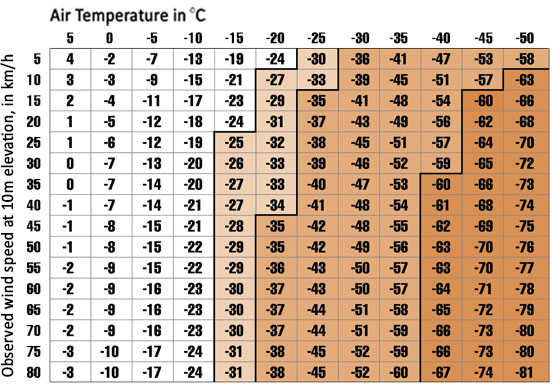
Approximate Thresholds:
Wind-chill at or below -25°C: risk of frostbite in prolonged exposure.
Wind-chill at or below -35°C: frostbite possible in 10 minutes; warm skin, suddenly exposed. (Shorter time if skin is cool at the start.)
Wind-chill at or below -60°C: frostbite possible in less than two minutes; warm skin, suddenly exposed. (Shorter time if skin is cool at the start.)
Take a snowmobile driver-training course
If you are between 12 and 15 years of age, or if you are 16 and older and do not have a valid Ontario driver’s licence, you must successfully pass a snowmobile driver-training course to get your operator’s licence. A snowmobile driver-training course can also be a valuable refresher for licensed and experienced snowmobilers.
The course takes about six hours and is usually held over three days. It covers safe driving practices, snowmobile laws, knowledge of the snowmobile, maintenance, driving positions, survival, first aid, night driving, trail signs, clothing and storage. It also teaches safe and courteous driving habits and skills to help you avoid collisions and property damage.
The training course is offered by the Ontario Federation of Snowmobile Clubs (OFSC) in co-operation with the Ministry of Transportation and is offered by club instructors trained by the OFSC. For the location of the nearest OFSC member club offering the course and the cost, contact the OFSC Driver Training Office at 501 Welham Road, Unit 9, Barrie, ON, L4N 8Z6. Phone 705-739-7669 or fax 705-739-5005. You can visit the OFSC website.
The snowmobiler’s code of ethics
Follow this code of ethics, and you will do your part to make snowmobiling a respectable, fun and safe winter recreation.
- I will be a good sportsperson and conservationist. I recognize that people judge all snowmobilers by my actions. I will use my influence with other snowmobilers to promote responsible conduct.
- I will not litter trails or camping areas. I will not pollute lakes or streams. I will carry out what I carried in.
- I will not damage living trees, shrubs or other natural features.
- I will respect other people’s property and rights.
- I will lend a helping hand when I see someone in distress.
- I will make myself and my snowmobile available to assist in search-and-rescue operations.
- I will not interfere with or harass hikers, skiers, snowshoers, people who are ice fishing or participating in other winter sports. I will respect their rights to enjoy recreation facilities.
- I will know and obey all federal, provincial and local rules regulating the operation of snowmobiles in areas where I use my snowmobile.
- I will not harass wildlife. I will avoid areas posted for the protection of wildlife.
- I will not drive where snowmobiles are prohibited.
Summary
By the end of this section, you should know:
- The licensing requirements to operate a snowmobile on roads and trails
- The importance of checking your snowmobile, preparing for trips and wearing proper protective gear
- Where you can and cannot drive your snowmobile
- The dangers of alcohol and driving on frozen lakes and rivers
- Hand signals, trail signs and traffic signs specific to snowmobiles
Driving an Off-road vehicle
Off-road vehicles (sometimes called ORVs) are any two- or three-wheeled motorized vehicles, as well as specific vehicles with four or more wheels as prescribed by regulation, intended for recreational use. Examples of off-road vehicles include all-terrain vehicles (ATVs), two-up ATVs, side-by-side ATVs, utility terrain vehicles (UTVs), amphibious ATVs, off-road motorcycles and dune buggies.
Note: Electric and motorized scooters (commonly known as go-peds) and pocket bikes (which are miniature motorcycles about two feet in height and with a speed of 70-80 km/h) are not off-road vehicles and, as such, cannot be registered as off-road vehicles. These vehicles also do not comply with motorcycle standards and cannot be registered as motorcycles.
I. Getting ready to drive an off-road vehicle
What you need to drive an off-road vehicle in Ontario
You must be 12 years of age or older to drive an off-road vehicle, except on land occupied by the vehicle owner or under the close supervision of an adult. Direct and close supervision by an adult is recommended.
While off-road vehicles are generally not allowed on public roads, there are some exceptions. (See the section "Where you can and cannot drive.")
Registering and insuring your off-road vehicle
Off-road vehicles must be registered with the Ministry of Transportation at a ServiceOntario centre. This applies to both new and used vehicles. You must be 16 years or older to register an off-road vehicle, and you must be able to prove you own the vehicle.
If you buy a new off-road vehicle, you must get a certificate of sale from the dealer.
If you buy or transfer ownership of a used off-road vehicle, you must present the signed vehicle portion of the vehicle permit from the previous owner.
You must pay a fee to register your off-road vehicle. After registering, you will be given a vehicle permit and licence plate. You should carry the vehicle permit at all times unless you are operating the vehicle on land occupied by the owner of the vehicle.
If you have a two- or three-wheeled vehicle, attach the licence plate to the front of the vehicle in plain view. If you have a vehicle with four or more wheels, attach the licence plate to the rear of the vehicle.
You must register your vehicle within six days of becoming the owner. If you change your address, you must notify the Ministry of Transportation within six days of the change. You may do this in person at a ServiceOntario centre, by mail to the Ministry of Transportation, P.O. Box 9200, Kingston, ON K7L 5K4, or on the ServiceOntario website.
If you are driving your off-road vehicle anywhere other than on the vehicle owner’s property, you must also have vehicle liability insurance. You must carry the insurance card with you and show it if requested by a police officer. If someone else uses your off-road vehicle with your consent, you are both responsible for any penalties, damages or injuries that may occur.
The following vehicles do not need to be registered as off-road vehicles: road-building machines, farm vehicles, golf carts and motorized wheelchairs. In addition, off-road vehicles participating in a rally or competition sponsored by a motorcycle association with more than 25 members do not need to be registered for the event.
Wear a helmet
You must wear a motorcycle helmet, as required by the Highway Traffic Act, whenever you drive or ride on an off-road vehicle or on any vehicle towed by an off-road vehicle. The only exception is when you operate the vehicle on the property of the vehicle owner. The helmet must meet the standards approved for motorcycle helmets, or motor-assisted vehicle helmets, and must be fastened properly under the chin.
Protect your face and body
Always wear a face shield or goggles. A face shield can help prevent windburn, sunblindness and watering eyes from the wind. It can also protect your eyes from branches and twigs when driving through wooded areas. Wear pants that cover your legs, a long-sleeved shirt or jacket to protect your arms and gloves. Boots should be high enough to cover your ankles. To make yourself more visible to others while driving, wear brightly coloured clothing.
Make sure your vehicle is in good condition
Before every trip, check your vehicle to make sure it is in good working order. Your life may depend upon it. Check the vehicle thoroughly before you start to drive, including the following:
- Check the brake control to make sure it moves freely. Adjust if necessary.
- Check that the throttle opens and closes smoothly in all steering positions.
- Check the condition of the tires and tire pressure.
- Check the fuel lines andconnections to make sure there are no leaks.
- Check that you have enough fuel and oil.
- Check that the engine is running smoothly. Make sure the is in neutral before starting the engine.
- Check that your lights are in good working condition.
Before you drive anywhere, read the owner’s manual.
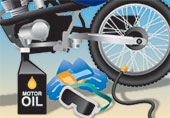
Be well prepared for every trip
Carefully preparing for every trip is an important safety measure. Check local weather forecasts and make sure you tell someone where you will be travelling and when you expect to be back. Use the buddy system; drive with others, not alone. Take along a first-aid kit, a vehicle repair kit, an extra ignition key, a drive belt, spark plugs and a rope. On long trips, include a map and a compass (or a GPS unit and know how to use it), flashlight, hunting knife, hatchet, extra fuel and matches in a waterproof box.
II. Safe and responsible off-road vehicle driving
Where you can and cannot drive
You may not drive an off-road vehicle on most public roads in Ontario. This includes the area between the boundary or property lines, including medians, shoulders and ditches.
There are some exceptions:
- You may drive an off-road vehicle directly across some public roads.
- You may drive certain off-road vehicles with three or more wheels along some public roads when using the vehicle for farming, for licensed hunting or for the trapping of fur-bearing animals, provided that the vehicle weighs 450 kilograms or less and does not have an overall width greater than 1.35 metres (excluding mirrors).
- You may drive an off-road vehicle within a provincial or public park if it is permitted by the park authority.
- Emergency personnel, such as police officers and firefighters, who are performing necessary duties in the course of their work or who are responding to an emergency, may drive off-road vehicles on public roads.
There are also exceptions for the category of off-road vehicles known as all-terrain vehicles (ATVs).
If you do drive an off-road vehicle on or across a public road, you must be at least 16 years of age and have a valid Ontario driver’s licence (Class G2, M2 or higher).
You may not operate an ATV in such a way as to disrupt or destroy the natural environment, including fish habitats, property and plants or trees.
For more specific information on where you may operate off-road vehicles, and what rules you must follow when doing so, you should refer to the Highway Traffic Act and the Off-road Vehicles Act.
All-terrain vehicles (ATVs)
All-terrain vehicles are off-road vehicles with the following characteristics: four wheels, all of which are in contact with the ground; steering handlebars; and a seat designed to be straddled by the driver.
There are sections of provincial highways in Ontario where you may drive an ATV on the shoulder, provided the ATV weighs 450 kilograms or less, does not have an overall width greater than 1.35 metres (excluding mirrors), meets the requirements of the federal Motor Vehicle Safety Act and the American National Standards Institute Standard, and is designed to carry only a driver and no passengers. You must travel in the same direction as the traffic using that side of the road. If there is no shoulder, if the shoulder is obstructed or if you are crossing a level railway crossing, you may drive your vehicle on the paved part of the highway. Keep as close as safely possible to the right of the shoulder or edge of the highway as you can.
Where a road or highway falls under the authority of a municipality, the municipality must enact a bylaw for ATVs to be allowed access to the road. If there is no bylaw in place, you cannot drive an ATV on that road. The municipality may also pass bylaws to decide where andwhen ATVs may be used on these local roads.
For those roads and highways where you are permitted to drive an ATV, you must obey all licensing and operational requirements, and your vehicle must conform to all equipment requirements, as listed in the Highway Traffic Act and the Off-road Vehicles Act. Remember the following rules:
- You must have a valid Ontario driver’s licence (G2, M2 or higher).
- You must wear a motorcycle helmet with a chin strap that is securely fastened.
- You cannot carry passengers on your vehicle.
- You must drive at speed limits lower than those posted: where the posted speed is 50km/h or less, you must drive 20 km/h or less; where the posted speed is over 50 km/h, you must drive 50 km/h or less.
In general, ATVs are not permitted on controlled-access highways, such as the 400 series highways and most parts of the Trans-Canada Highway, but are allowed access to highways 500 to 899, the 7000 series highways and highways with low traffic volumes.
For more details about which highways ATVs may drive on, please refer to the Highway Traffic Act, Ontario Regulation 316/03.
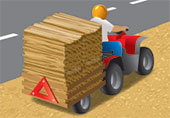
Obey the rules
You must stop if a police officer signals you to do so. You can also be stopped by a landowner when you are driving on private property. If signalled to stop by an authorized person, you must stop and, if asked, properly identify yourself.
Everyone who drives an off-road vehicle without care and attention or without reasonable consideration for other people and property may be charged with careless driving. Other offences, such as dangerous driving and alcohol related offences, apply to drivers of off-road vehicles. When you drive an off-road vehicle on a public road, the Highway Traffic Act offences also apply.
Report collisions to the police
You must report to the police immediately any collision on a public highway that results in injury to any person or damage to property apparently exceeding $2,000.
Do not drink and drive
It is against the law to drive an off-road vehicle when you are impaired by alcohol or drugs.
Drinking and driving is a deadly combination.
Consuming any amount of alcohol before you ride affects your ability to make good decisions. Even one drink can reduce your ability to concentrate and react to things that happen suddenly when you are driving. With more alcohol in your blood, you could have trouble judging distances and your vision may become blurred. Factors like tiredness, your mood, and how long ago you ate and how much, can make a difference in how alcohol affects your driving ability.
The police can stop any driver to determine if alcohol or drug testing is required. They may also do roadside spot checks. When stopped by the police, you may be told to blow into a machine that tests your breath for alcohol, a roadside screening device, or perform physical co-ordination tests. If you fail or refuse to provide a breath sample or to perform the physical co-ordination tests, you will be charged under the Criminal Code.
If the reading on the machine shows you have been drinking, you may be taken to a police station for a breathalyzer test. The breathalyzer uses your breath to measure the amount of alcohol in your bloodstream.
If you cannot give a breath sample or it is impractical to obtain a sample of breath, the police officer can require you to provide a blood sample instead.
If the police believe that a driver is impaired because of the consumption of a drug or a combination of alcohol and a drug, they can also require a driver to submit to an evaluation and then require a driver to provide blood, oral fluid or urine samples. If you fail or refuse to comply with any of these demands, you will be charged under the Criminal Code.
Driving impaired or with more than 80 milligrams of alcohol in 100 millilitres of blood (.08) is an offence under the Criminal Code. Even if your blood-alcohol concentration (BAC) is less than .08, you can still be charged with impaired driving under the Criminal Code.
You will receive an immediate 90-day administrative driver’s licence suspension if BAC is more than .08 or if you fail or refuse to provide a breath or bodily fluid sample, perform a physical co-ordination test or submit to an evaluation.
If you register in the “warn range” of .05 to .08 on a roadside screening device, you will receive an immediate driver’s licence suspension. For a first occurrence, you will be suspended for three days. For a second occurrence in a five-year period, you will be immediately suspended for seven days and you must undergo a remedial alcohol-education program. For a third or subsequent time in a five-year period, you will be immediately suspended for 30 days, and you must undergo a remedial alcohol-treatment program and have an ignition interlock condition placed on your licence for six months. If you choose not to install an ignition interlock device, you must not drive until the condition is removed from your licence.
If you are 21 years old and under and hold a full-class driver’s licence, you must not drive if you have been drinking alcohol. Your blood-alcohol level must be zero. If you are caught driving with alcohol in your blood, you will receive an immediate driver’s licence suspension at the roadside for 24 hours and, if convicted, you will face a fine and a 30-day licence suspension.
Drivers of all ages in either Level One or Level Two of Ontario’s graduated licensing system must also have a blood-alcohol level of zero when driving. New drivers caught drinking and driving will receive an immediate driver’s licence suspension at the roadside for 24 hours and, if convicted, will face a fine and will receive a suspension period as per the Novice Driver Escalating Sanctions scheme. For the first occurrence, you will be suspended for 30 days. For the second occurrence, in a five-year period, you be suspended for 90 days. For the third occurrence in a five-year period, the novice portion of your driver’s licence will be cancelled, and you must reapply for a G1 licence.
Novice drivers will also be charged under the Criminal Code if their BAC exceeds .08 and will be issued a “warn range” suspension if they register a BAC from .05 to .08.
Drugs
Any drug that changes your mood or the way you see and feel about the world around you will affect the way you drive. Criminal Code and HTA sanctions apply to drivers impaired by alcohol or a drug.
In circumstances involving possible impairment by a drug or a combination of alcohol and a drug, police can require a driver to perform physical co-ordination tests and to submit to an evaluation and then require a driver to provide blood, oral fluid or urine samples. If you fail or refuse to comply with any of these demands, you will be charged under the Criminal Code. You will also receive an immediate 90-day administrative driver’s licence suspension.
Illegal drugs such as marijuana and cocaine are not the only problem. Some drugs that your doctor may prescribe for you and some over-the-counter drugs can also impair your driving. Here are some points you should remember:
- If you use prescription medicines or get allergy shots, ask your doctor about side effects such as dizziness, blurred vision, nausea or drowsiness that could affect your driving.
- Read the information on the package of any over-the-counter medicine you take. Any stimulant, diet pill, tranquillizer or sedative may affect your driving. Even allergy and cold remedies may have ingredients that could affect your driving.
- Drugs and any amount of alcohol together can have dangerous effects, even several days after you have taken the drug. Do not take a chance; ask your doctor or pharmacist.
Do not carry passengers
Do not carry passengers on an off-road vehicle designed for one person. Carrying passengers changes the weight distribution of the vehicle and limits your ability to shift position on the vehicle for control and stability.
Practice safe driving skills
Driving an off-road vehicle is different than driving any other type of vehicle, and takes more skill than you might think. Be sure to read your owner’s manual before you begin to drive.
If you are a beginner, practise driving your vehicle in an open area that is free of obstacles, until you become skilled at handling it. Choose ground that is uniform, either dirt, sand or snow. Avoid paved surfaces when driving an off-road vehicle. ATVs are designed for off-road use and are more difficult to manoeuvre on paved surfaces. When driving, keep both feet on the footrests at all times. Do not try to stabilize a tipping vehicle by putting your foot down. You could run over your foot or leg.
Be extremely careful driving through water. Driving fast across unknown water is dangerous. Hidden rocks or holes could throw you off the vehicle and cause serious injury or drowning. First, check that the water is not too deep. Drive slowly and carefully so you can steer around rocks and other obstacles.
Always use a flag mast when driving in dunes and hills. Remember that you need a running start to climb most hills. Be extra cautious when driving among pedestrians, horseback riders, sunbathers or bicyclists.
Read the Snowmobiler’s Code of Ethics, and follow it when driving your off-road vehicle.
Summary
By the end of this section, you should know:
- The licensing requirements to operate an off-road vehicle on roads and trails
- The importance of checking your off-road vehicle, preparing for trips and wearing proper protective gear
- Where you can and cannot drive your off-road vehicle
- The dangers of alcohol and driving an off-road vehicle